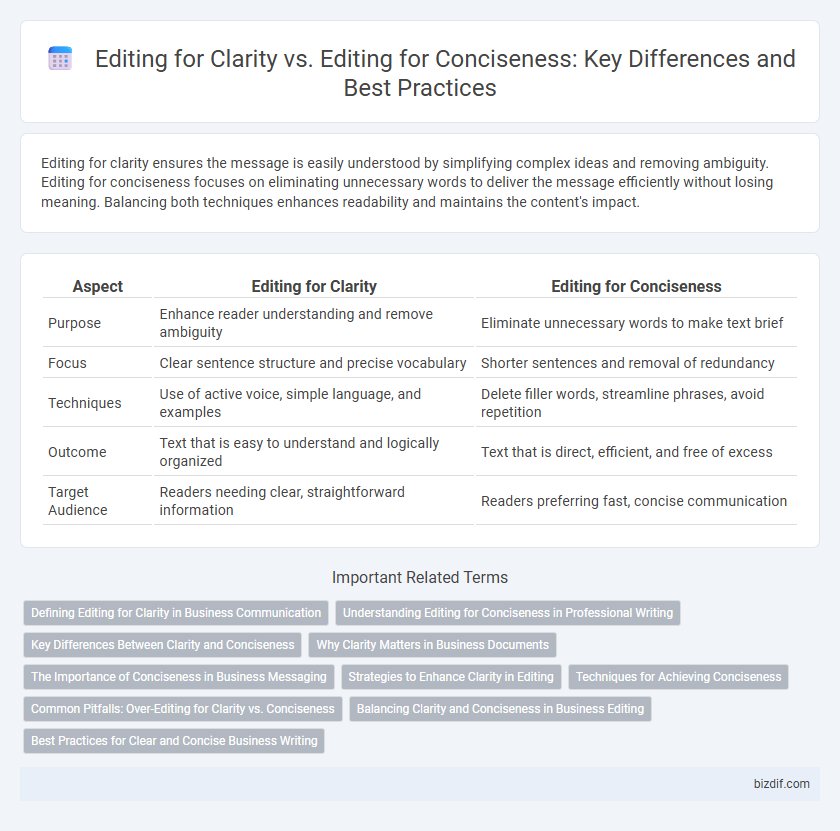Editing for clarity ensures the message is easily understood by simplifying complex ideas and removing ambiguity. Editing for conciseness focuses on eliminating unnecessary words to deliver the message efficiently without losing meaning. Balancing both techniques enhances readability and maintains the content's impact.
Table of Comparison
| Aspect | Editing for Clarity | Editing for Conciseness |
|---|---|---|
| Purpose | Enhance reader understanding and remove ambiguity | Eliminate unnecessary words to make text brief |
| Focus | Clear sentence structure and precise vocabulary | Shorter sentences and removal of redundancy |
| Techniques | Use of active voice, simple language, and examples | Delete filler words, streamline phrases, avoid repetition |
| Outcome | Text that is easy to understand and logically organized | Text that is direct, efficient, and free of excess |
| Target Audience | Readers needing clear, straightforward information | Readers preferring fast, concise communication |
Defining Editing for Clarity in Business Communication
Editing for clarity in business communication involves refining text to ensure the message is easily understood by the target audience. It emphasizes clear sentence structure, precise word choice, and logical flow, reducing ambiguity and enhancing comprehension. This type of editing prioritizes transparency and straightforwardness to facilitate effective decision-making and collaboration.
Understanding Editing for Conciseness in Professional Writing
Editing for conciseness in professional writing involves eliminating redundancy and choosing precise vocabulary to enhance readability and efficiency. Unlike editing for clarity, which aims to ensure the reader comprehends the message, editing for conciseness focuses on reducing wordiness without sacrificing meaning. Mastering this skill improves communication by delivering information directly and effectively, essential in business reports, proposals, and technical documents.
Key Differences Between Clarity and Conciseness
Editing for clarity prioritizes making the text easily understandable by enhancing sentence structure, word choice, and logical flow to ensure readers grasp the intended message without confusion. Editing for conciseness focuses on eliminating unnecessary words, redundancies, and filler to make the content brief and direct while retaining essential information. The key difference lies in clarity aiming for comprehension and readability, whereas conciseness targets brevity and efficiency in communication.
Why Clarity Matters in Business Documents
Clarity in business documents ensures the message is easily understood, reducing the risk of miscommunication and costly errors. Clear editing prioritizes transparency and precision, enabling stakeholders to make informed decisions quickly. Focusing on clarity improves professionalism and trust, which are essential for effective business communication.
The Importance of Conciseness in Business Messaging
Conciseness in business messaging enhances clarity by eliminating unnecessary words, allowing key ideas to stand out and promoting quicker comprehension. Efficiently edited messages respect the recipient's time while reducing the risk of misinterpretation and information overload. Prioritizing brevity strengthens professionalism and increases the impact of communication in fast-paced corporate environments.
Strategies to Enhance Clarity in Editing
Editing for clarity prioritizes straightforward language, precise word choice, and logical sentence structure to ensure the reader easily comprehends the message. Techniques such as breaking down complex sentences, eliminating ambiguous terms, and using active voice significantly enhance readability. Incorporating consistent terminology and clear transitions also strengthens the overall coherence of the text.
Techniques for Achieving Conciseness
Techniques for achieving conciseness in editing include eliminating redundant words, replacing lengthy phrases with precise terms, and removing unnecessary modifiers. Using active voice and concise sentence structures enhances readability and sharpens the message. Precision-focused editing reduces wordiness while maintaining clarity, ensuring the content remains impactful and easy to understand.
Common Pitfalls: Over-Editing for Clarity vs. Conciseness
Over-editing for clarity can lead to unnecessarily lengthy explanations that overwhelm readers, while excessive focus on conciseness risks stripping essential context and nuance from the text. Balancing clarity and conciseness requires maintaining the core message without redundancy or ambiguity, avoiding pitfalls such as jargon overuse or message dilution. Effective editing preserves meaning and readability, ensuring the audience fully comprehends the content without cognitive overload or information loss.
Balancing Clarity and Conciseness in Business Editing
Balancing clarity and conciseness in business editing ensures messages are both easily understood and efficiently communicated, avoiding unnecessary verbosity that can dilute key points. Prioritizing clear language with precise word choices enhances readability while maintaining the essential information needed to drive decisions and actions. Effective business editing streamlines content without sacrificing the nuance and detail required for accurate interpretation.
Best Practices for Clear and Concise Business Writing
Editing for clarity involves refining sentence structure and word choice to ensure the message is easily understood, while editing for conciseness eliminates redundant phrases and unnecessary jargon to enhance readability. Best practices for clear and concise business writing include using active voice, favoring simple words over complex ones, and breaking long sentences into shorter, more digestible parts. Prioritizing clarity and conciseness together improves communication effectiveness, making business documents direct, professional, and reader-friendly.
Editing for Clarity vs Editing for Conciseness Infographic

 bizdif.com
bizdif.com